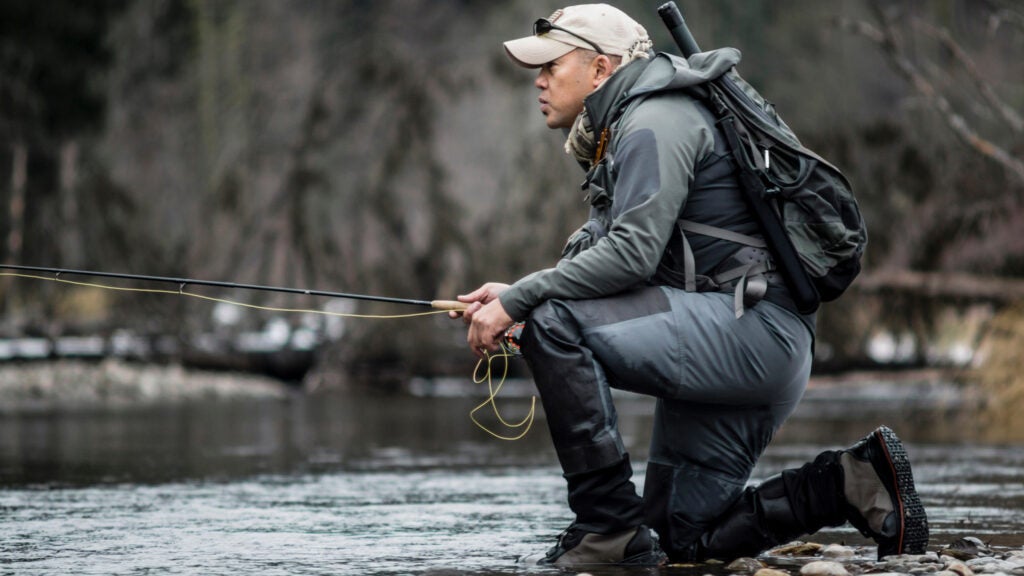No products in the cart.
Outdoor Adventure
The Best Fly Fishing Gear (2024): Rods, Waders
The bad news is trout aren’t getting dumber. More flies on the surface and extra boots in the water mean you have to approach these fish with stealth and finesse. The good news: our 2024 gear selections won’t make the cast or catch a fish for you, but they sure help level the playing field. Last summer and fall, four testers took over 40 items from Idaho to British Columbia to narrow down the very best options for you.
At a Glance
All gear in this guide was tested by multiple reviewers. When you buy through our links, we may earn an affiliate commission. This supports our mission to get more people active and outside. Learn more.
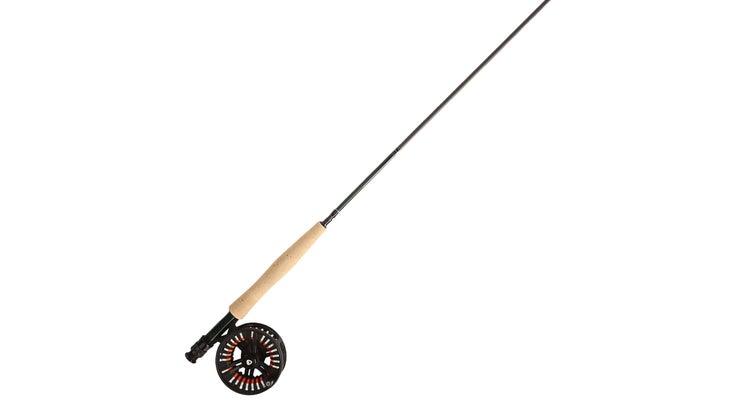
Greys Cruise Fly Rod/Reel Combo 9’ 5-Weight
$190 at BassPro $190 at Cabela’s
Weight: 2 lbs
Pros and Cons
⊕ Great beginner rod
⊗ Action makes long casts with heavy flies difficult
Bottom line: This wallet-friendly kit performs well in 90 percent of fly-fishing situations.
If you buy the Cruise kit, it’s for budget reasons. The reel is die-cast instead of machined, and the rod components, guides, wraps, and others are modest compared to higher-end options. That said, this four-piece, medium-action, easy-to-cast rod comes with everything you need to get started—a large-arbor disk-drag reel, backing, a weight-forward floating line, a leader, and a protective tube. It casts dries and small nymphs nicely between 20 and 50 feet; however, with heavier nymphs and streamers—including bead-head and cone-head varieties—our casts often folded at 40 to 60 feet. Still, if you’re buying for a beginning fly-fisher or want an extra stick when your go-to rod fails, you can’t get such decent quality for a better price. Have a kids’ birthday coming up? Make them smile.

Orvis Helios D 9’ 5-Weight Fly Rod
$1,098 at Backcountry $1,098 at Orvis
Weight: 3.06 oz
Size: 10’ 4-wt to an 8’5” 14-wt
Pros and Cons
⊕ Extremely accurate
⊕ Made in distance (D) and finesse (F) models
⊗ Pricey
Bottom line: If the most technologically advanced fly rod ever built is your jam, Helios is your rod.
Anglers rarely need to throw an entire fly line—unless there’s a unique fish on the far bank, or they’re showing off. One of our testers is that showoff at the boat ramp; last fall, he threw an entire line with Orvis’ new 9’ 5-weight Helios after having tested the rod for several days on Montana’s broad Missouri River. Nobody asked for his autograph, but a few onlookers did ask him which rod he was using. The Helios is available in distance (D) and finesse (F) options and 29 length and weight combinations. We found that a 9-foot 5-weight is perfect on most trout waters. We chose the finesse model when fishing light tippets for large fish, especially on flat-surfaced spring creeks, tailwaters, and still waters. The distance model was our go-to when throwing most dry flies, along with streamers and nymphs. This rod is highly accurate and fast thanks to its stellar build, which means over-lining it one stop (for instance, using a 6-weight line, versus a 5-weight) might improve its feel if the rod doesn’t load to your liking.
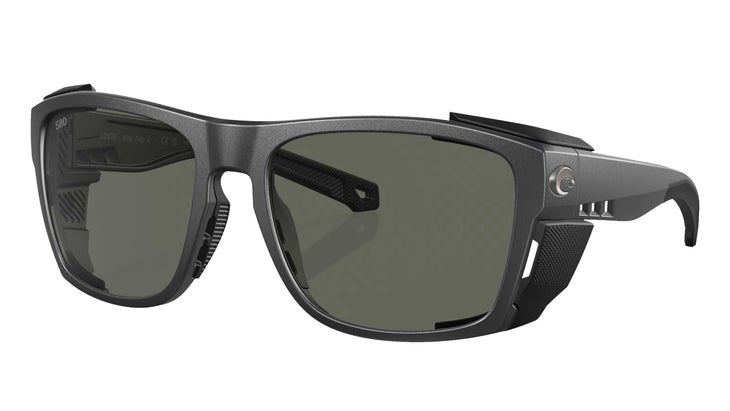
Costa King Tide Sunglasses
Weight: 8-base frame 49g (including side shields and lenses); 6-base frame 48g
Size: L
Pros and Cons
⊕ Pair with any 580 lens
⊕ Removable side shields offer full light blockage
⊕ Adjustable nosepiece allows custom fit and excellent ventilation
⊕ Non-skid material on top of frame
⊕ Available in RX
⊗ Price
⊗ One frame color
Bottom line: This was the most versatile frame we tested with a variety of high-quality lens choices.
I didn’t need Costa’s King Tide shades to see the bluefin tuna off Southern California’s Coronado Island—those breezers often broke the surface within the boat’s casting range. But, I was very grateful for their protection during what, unexpectedly, turned out to bea 16-hour day on the ocean, partly in the glaring sun. The removable side shields offered excellent light and wind protection, and the adjustable nose piece held the frame off my high cheeks and kept the air flowing to prevent any fogging. Their rubber, non-slip pads (located on the top of the shields) held the glasses in place when I set them on various surfaces, even while we were pitching on the Pacific. Word to the wise: if you do remove the side shields, the King Tides slide off surfaces like any other glasses, which risks shattering lenses. The King Tides are available in a variety of 580 lens tints. For testers, Blue Mirror and Green Mirror worked well on the Pacific, and Copper/Silver Mirror and Sunrise/Silver Mirror were solid choices for freshwater.
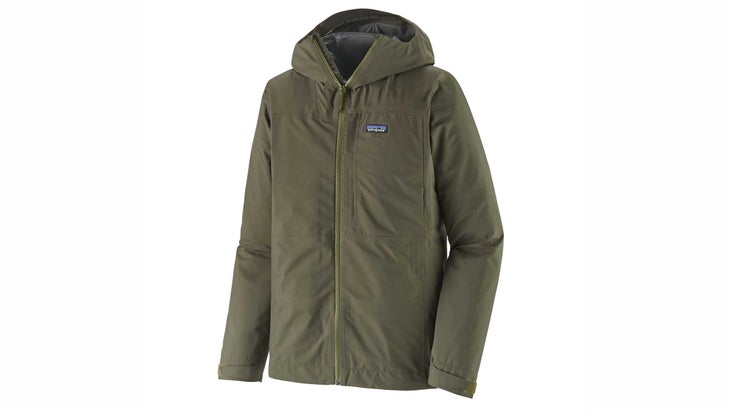
Patagonia Boulder Fork Rain Jacket
$229 at REI (Men’s) $299 at REI (Women’s)
Weight: 3.7 oz
Size: S, M, L
Pros and Cons
⊕ Streamlined
⊕ Low bulk
⊕ Three large pockets
⊕ Longer cut for additional protection
⊗ Longer cut could allow water in hand pockets during deep wades
Bottom line: The multi-activity jacket that served us best in the backcountry fly-fishing arena.
You can get more pockets, zippered ventilation, and neoprene cuffs on fly-fishing-specific jackets, but those extra features add bulk and weight, which doesn’t serve well when hitting off-the-grid waters. This streamlined 3-layer jacket with DWR coating kept us dry and didn’t snag when we crept through the brush and morning dew on northern Idaho’s native cutthroat waters. The jacket packs down to softball size and is easily stuffed into our waistpacks and daypacks. A large fly box fit nicely in the lay-flat chest pocket, which gave us adequate fly choices during full days in the backcountry. Two side pockets held additional gear, such as split shot, gloves, and tippet. An adjustable draw-cord hood fit well, whether we wore a ball cap or stocking hat, and effectively prevented windblown rain from creeping past the collar and down our necks and backs.
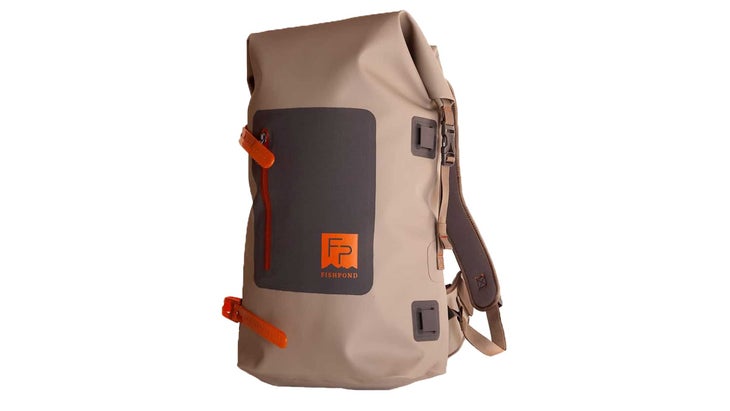
Fishpond Wind River Roll-Top Backpack
$230 at Amazon $230 at Fishpond
Weight: 3.6 lbs
Size: 38L; 31” tall unrolled; 24” rolled three times
Pros and Cons
⊕ Keeps gear dry
⊕ Carries two rod tubes
⊕ Removable hip belt
⊗ No exterior side pocket for water and/or bear spray
Bottom line: When critical gear must remain dry, this is our bag.
We carried this soft-sided pack to Alaska, testing it during a challenging week of weather that ranged from light drizzle to full-blown rain and gale-force winds that grounded floatplanes for days. We tossed the Wind River onto the floors of open aluminum skiffs, packed it through the willows and head-high grasses, and the rugged TPCU-coated exterior, combined with roll-top security, kept our gear—including cameras and lenses—dry. The new Wind River offers a thermoformed back panel and an adjustable hip belt that always kept us comfortable. The hip belt is also removable, which allowed this bag to easily slide into overhead compartments on commercial flights and slip, unencumbered, into the piles of gear that ride in a floatplane’s rear fuselage and pontoons. Note: Alaska pilots detest hard-side roller duffels and they’ll tell you as much (they aren’t pliable, take up more space, and are heavier than soft-sided gear). Luckily for us, the Wind River passed the pilot’s soft-sided test for packability. Plastic straps on the front of the bag allowed us to carry two rod tubes at a time.
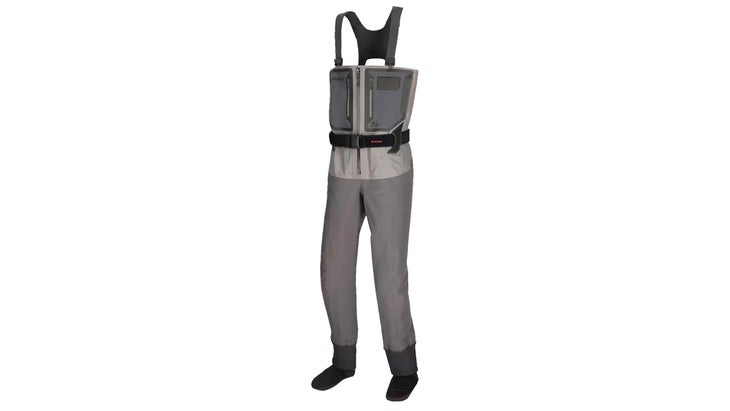
Simms G4Z Stockingfoot Waders
$1,000 at Backcountry $1,000 at Simms
Weight: 47.2 oz
Size: S, M, MK, L, LK, XL, XXL
Pros and Cons
⊕ Sleek and easily adjustable harness/suspender system
⊕ Bonded center zipper more pliable/comfortable than previous stitched-in models
⊕ Two interior, fully submersible zippered pockets
⊗ Pricey
⊗ Hot on warmest summer days
Bottom line: This high-end wader performs flawlessly in all seasons and on all waters.
I never wanted a Cadillac, nor could I have afforded one, but I’ll sure hit the water in Cadillac-quality waders, which is exactly what the SimmsG4Zs are. These waders offer a new sleek harness and suspender system that’s easily adjusted by lockdown clasps, and the excess suspender straps slide into external chest pockets, which makes on-the-water fit adjustments a snap. Simply unlock the clasp, place a hand in a front pocket, pull down on the strap, and re-lock for a secure and custom fit. Simms also extended the wader’s four-layer Gore-Tex Pro Shell fabric to the crotch and seat, making these more robust in the highest wear areas, a design touch we appreciate in an expensive wader. The upper portion of the wader is a three-layer Gore-Tex Pro Shell material, where a front and center zipper is now bonded, rather than stitched, to the fabric.. The result of that three-layer fabric and bonded zipper combination is a more pliable and therefore comfortable feel. We also liked the generous fit that was easier to get in and out of than other waders we tested.
We tested these waders on 80-degree late-summer and fall days, and on winter days with temperatures in the 40s and wind gusts of up to 30 miles an hour. On the warmest days, you’ll get hot under the four-layer fabric and likely need to open the center zipper for ventilation, which works well. Additionally, a new velcro wading belt is easily adjustable and allows for increased interior airflow when needed. On cooler mornings and summer evenings, you can wear multiple layers under the G4Zs and not be restricted in movement. These fit well—not tight, yet we didn’t feel like we were wading in a garbage bag. Two interior waterproof chest pockets open and close with TRU Zip zippers and kept our essentials, like cell phones and licenses, completely dry.
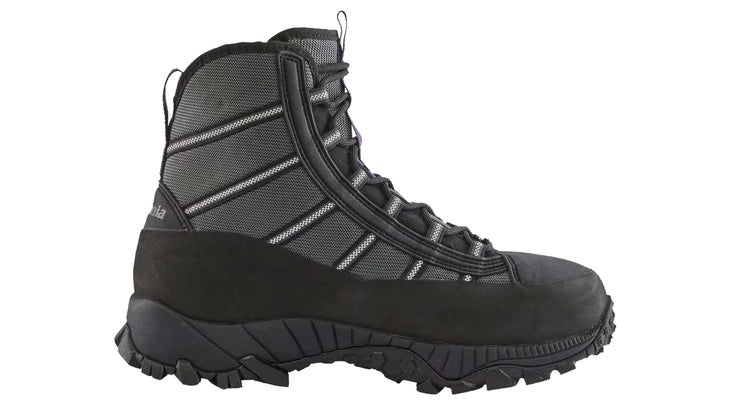
Patagonia Forra Wading Boot
$299 at Backcountry $299 at Patagonia
Weight: 41 oz
Pros and Cons
⊕ Lightweight
⊕ Quick drying
⊕ Comfortable enough to hike in
⊗ With no foam backing on the upper they could rub the ankle bone
Bottom line: This high-end wader performs flawlessly in all seasons and on all waters.
There are a few main reasons I would own Forra boots: they are lightweight, they lace tight, offer excellent toe and heel protection, and are perfect for all-day hikes and overnights. The mostly dry upper dries fast and helps keep the weight down, which was nice for backcountry missions, and stuffing them in our duffel for flights.
However, we should all take Patagonia’s marketing verbiage, “super sticky grip” and slime-defying grip,” with a grain of salt. I would not dare wade the Madison, Clearwater, or Lochsa rivers (among others) without studs on these boots. Fortunately, they are available with a stud kit ($49), which makes this a non-issue.
Fly Fishing Questions and Answers
Do I need waders for summer fly fishing?
This question all depends on air and water temperatures. For instance, in the northern Rockies, even the dog days of summer may begin in the 40-degree range. With an early start, sans a solid base layer and waders, you might whimper back to the rig and wait for the sun to rise high. In Alaska, you might not even see the sun for a couple of days. In addition, waders protect you from stinging/biting insects and thorny vegetation. Wet-wading is a summer treat, but you should always have waders for backup against the weather, including summer thunderstorms that sometimes drop multiple inches of hail, and air temperatures by 20 or 30 degrees Fahrenheit in an hour.
Which dry flies do I need for summer fly-fishing?
You’ll need different flies for the different regions you fish. In general, you’ll cover mayfly, caddis, stonefly, and terrestrial hatches. Below is a quick guide to matching each of the below flies:
- Mayflies (sizes 14, 16, and 18): Parachute Adams’, Purple Hazes, Sparkle Duns, Rusty Spinners, and Quigley Cripples
- Caddis (sizes 12, 14, and 16): Caddis Variant, Cornfed Caddis, Peacock Caddis, and Outrigger Caddis
- Stoneflies (sizes 4, 6, and 8): Stimulators, Water Walker Golden Stones, Rogue Foam Salmonflies, and Morris Fluttering Stones
- Ants (sizes 4, 6, and 8): Amy’s Ant and Ant Acids
- Hoppers (sizes 14 and 16): Parachute Hoppers and Morrish Hoppers
Do I need polarized sunglasses to fly fish?
Technically, no. However, being able to see contrast and definition under the surface of the water gives an angler a huge advantage. You’ll spook fewer trout, see structures (boulders, logs, matts of grass) that attract fish, and you’ll avoid debris that might cause a stumble and fall in the water. Plus, you have a better shot at seeing fish before they see you.
How We Test
Number of Testers: 4
Number of Products Tested: Over 40
Number of Bodies of Water Tested in: 15
Four avid fly-fishers packed 40-plus items to various rivers and lakes this past year, testing that gear in several challenging locales, including Idaho, Montana, Alaska, California, and British Columbia. We set up and cast fly rods side by side, deep waded with a variety of waders—checking for leakage and comfort—and hung gear in rain, sleet, and snow—for up to 48 straight hours—to test if they could hold out the water. We considered fly lines and reels, rods, emergency equipment, wading boots, belts, staffs, base layers, packs, jackets, and more.
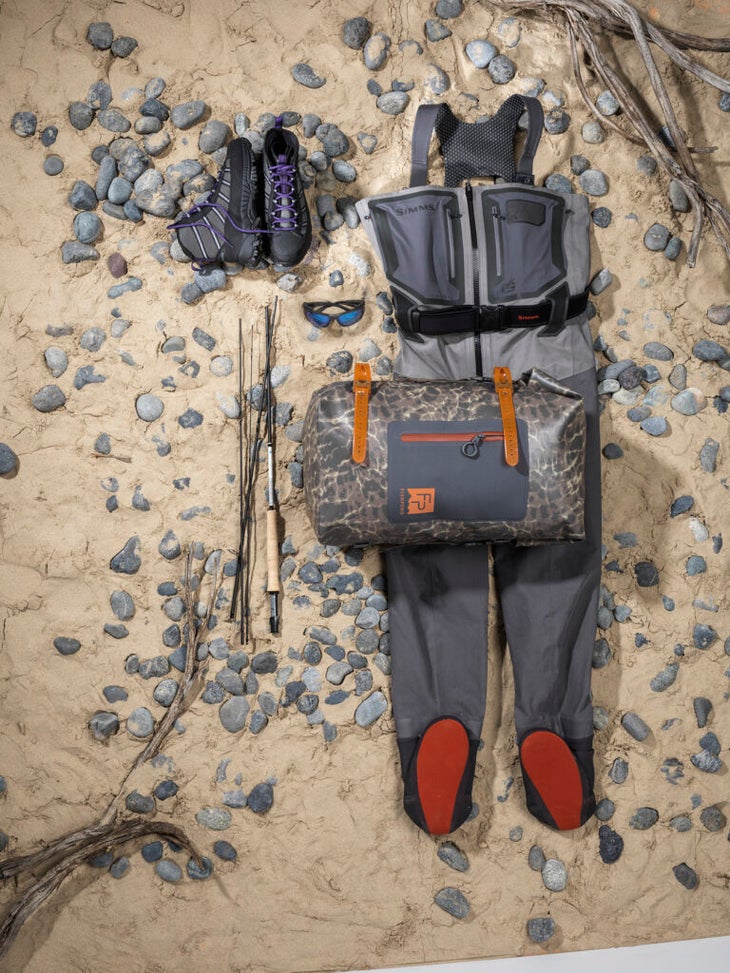
Meet Our Lead Testers
Greg Thomas
Greg Thomas is the owner of Angler’s Tonic and the former editor-in-chief of Fly Rod & Reel and American Angler magazines. He’s the author of Fly Bible: Montana and Fly Fisher’s Guide to Washington and, especially, enjoys time in the backcountry, hiking with his Labrador, Rye, casting to native fish in oft-overlooked places. He lives in Missoula, Montana.
Kelly Klein
Kelly Klein is the associate gear editor at Outside and a beginner at fly-fishing, so she enjoyed testing the products that made the learning curve less steep. Based in Bozeman, Montana, she tested gear on Montana’s upper Madison and Missouri rivers, the Colorado River, and Utah’s Green River.
Source link

